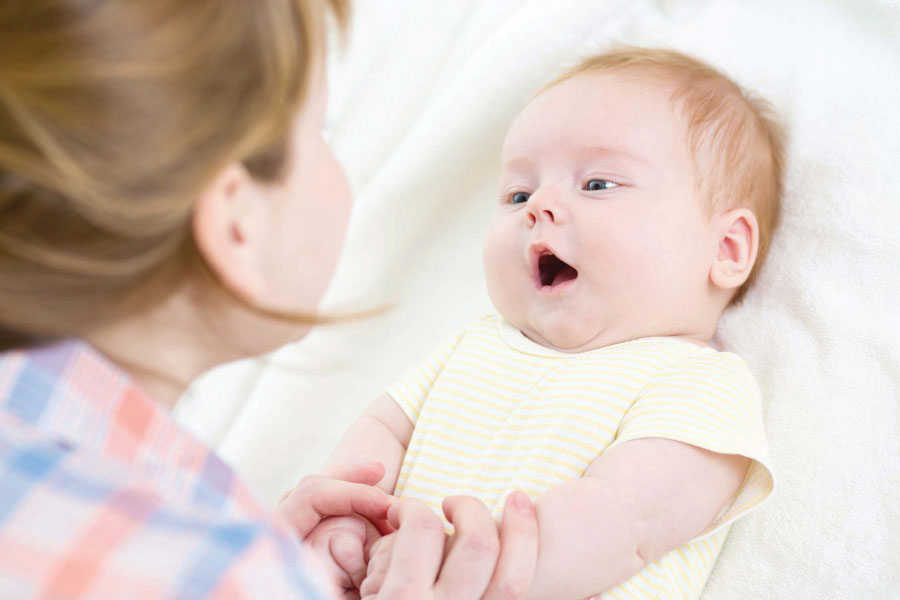Babies may not be able to talk, but if you pay close enough attention, you’ll find that they communicate well enough long before they even say their first words. In fact, according to Linda Acredolo, Ph.D., professor emeritus of psychology at University of California, and author of Baby Signs, babies have the ability to express several emotions, including distress and contentment. So, do you happen to be familiar with any of them yet?
The rooting reflex
The rooting reflex is when a newborn turns his head whenever something touches his cheek. This reflex is to help him locate his food. It disappears after the first few weeks. Then, whenever your baby turns to you, it is a cue that he’s hungry and wants to nurse.
You can use the rooting reflex to your advantage while your baby figures out feeding, where a simple touch of the cheek will prompt him to turn to the breast or bottle.
Smiling
Although babies may spontaneously smile without even knowing it, as they grow older, their smiles become intentional and meaningful. At the initial stages, a baby’s smile could be a signal of physical contentment, for instance when the little one feels warm and cozy in his mom’s arms. Later on, a baby will likely smile whenever he sees a loved one nearby.
Offer positive reactions like smiling back with gentle, loving words. Baby might not understand what you’re saying but he’ll definitely get the ‘message’ that mommy loves him.
Rubbing eyes and/or ears
Infants tend to rub their eyes and ears with their hands when they are starting to get sleepy or tired. They may even discover an ear by doing so, and this is when the habit of trying to soothe themselves by rubbing and/or pulling on the ear starts.
As soon as you see this happening, get the little one to bed. Note: If the ear-rubbing is accompanied by fussiness and a body temperature of over 101 degrees, he may have an ear infection and you should call your pediatrician.
The startle reflex
Babies are not yet accustomed to loud noises or even bright lights, so these may cause them to jerk and spread out their arms and legs before pulling them back in. A loud cry usually follows. This is known as the startle reflex and it’s a natural thing with babies — it goes away between three and six months.
Although startling doesn’t hurt the baby, it can feel scary and set off a crying fit. To recreate the security of the womb, where sound and light were muffled, try swaddling your baby with a comfy blanket.
Arching of the back
Starting a few weeks after birth, babies begin arching their backs when they’re in discomfort. It might mean he has reflux, especially when the arched back is combined with crying. Your baby may also squirm around and move to try to get to a more comfortable position.
If baby happens to be in a carrier, car seat or stroller, try taking him out for a few minutes; hold him upright against your shoulder, or give him some wiggle time on the floor. Babies also arch their backs when they’ve had enough to eat and want to move away from the breast.
Gaze aversion
If your baby turns his face away from you, it means he needs a break from eye contact. Sometimes, baby might even start to play with his fingers or toes, or even start crying — anything to break contact with an adult. They start to do this from the age of two months onward — it means they’re trying to disconnect form the source of stimulation due to being overwhelmed or overstimulated.
No matter how badly you want to engage your baby in play and laughter, you’ll need to pay due attention to the little one’s need for down time. Don’t worry for this won’t last — before you know it, he’ll be rested enough and ready to play again.
Being your copy-cat
By the time they’re six months old, most babies would be experts in imitating their parents’ or caregivers’ facial expressions and by nine months, they may even start to react to those expressions. Remember that if you’re feeling stressed, your baby will be too.
If it’s a minor case of anxiety, take some deep, cleansing breaths and consciously relax your facial muscles to ease tension. If your baby is already distressed, a hug or gentle pats will soothe and reassure him that everything is alright.
Get to know your baby’s cries
Crying is the quickest way for your baby to let you know he’s tired, hungry, in pain or just bored The question is, which cry is which? Here are the three main types cries.
Feed me, I’m hungry!
A baby will generally wake up hungry and crying for food with a short, low-pitched cry, just over a second in duration. If you don’t respond quickly, the cry becomes louder and more intense.
Respond to your baby as quickly as possible, especially in the first few months of life. You’re not going to spoil your baby by picking him up and feeding him right away. Tending to your baby’s hunger immediately teaches him that you’ll always be there to care for his needs.
The cry of pain/distress
This kind of cry comes on much more suddenly than a hunger cry. It’s about twice as long, and continuous — that is, it doesn’t rise and fall in pitch. Check for wet or soiled diaper. If that’s not it, check to see if baby is feeling too hot or too cold (both can be distressing for a baby). Check your baby over from head to toe.
Tired and/or very sleepy
Between two and three months, your baby’s cries will become more varied, and he may develop a cranky, “tired” cry. “It may be a softer variation of pain cry. If your baby’s been awake for a couple hours, it’s more than likely you’re hearing a sleepy cry, so get your little one to bed by means of whichever rituals you may have for this.
In time, you’ll get the hang of this and will be better able to decipher the meaning of each cry and act accordingly.



















